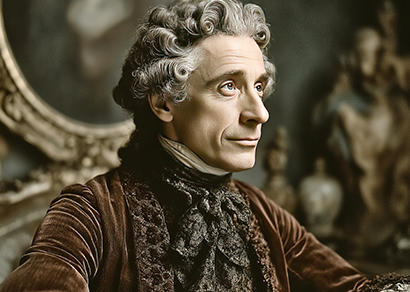

Literary studies
The intersection of narrative, psyche, and culture
Literature has long served as a profound mirror to the human condition, offering intricate portrayals of internal conflicts, emotional landscapes, and societal dynamics. It operates at the confluence of art and human science, where storytelling becomes a medium for exploring the complexities of the mind. Through character development, plot structure, and symbolic language, literary works provide a rich field for psychological inquiry and a powerful tool for self-reflection. This exploration connects the creative expression of authors with the universal quest for meaning, personal growth, and a deeper understanding of our shared humanity, bridging the gap between artistic creation and psychological awareness.

Literary masters as explorers
of the human mind
Long before the formalization of psychology as a scientific discipline, celebrated authors were conducting their own deep investigations into the human psyche. Through their characters, they dissected motivations, anxieties, and desires with remarkable intuition and precision.

Psychological realism in classic novels
Authors such as Fyodor Dostoevsky created characters whose internal monologues and moral dilemmas offered an unprecedented look into concepts like guilt, existential dread, and redemption, prefiguring many ideas later found in psychoanalysis.

The modernist stream of consciousness
Writers like Virginia Woolf and James Joyce pioneered the stream of consciousness technique, attempting to represent the unfiltered flow of a character’s thoughts and sensations, mirroring the fluid and associative nature of human cognition.

Existential themes in post-war literature
Following periods of great societal upheaval, authors like Albert Camus used narrative to explore themes of absurdity, freedom, and the search for purpose in a seemingly meaningless world, reflecting a widespread philosophical and psychological inquiry.

Narrative psychology
Narrative frameworks for self-understanding
The field of narrative psychology posits that humans are inherent storytellers who make sense of their lives by constructing personal narratives. These life stories are not merely recounts of events but are structured accounts that shape identity, values, and perception. The way individuals frame their past experiences and imagine their future selves influences their mental health and overall well-being. This process involves selecting specific events, creating causal links, and establishing overarching themes that provide a sense of coherence and continuity to one’s existence.
Literary fiction provides a powerful resource for understanding this process. By analyzing the structure of character arcs—from inciting incidents to resolutions—readers can gain insight into how narratives are built. This understanding can then be applied to one’s own life, allowing for a conscious reframing of personal stories. Ultimately, recognizing oneself as the protagonist of a personal journey can empower individuals to identify limiting beliefs, overcome obstacles, and actively shape the direction of their future chapters.

The therapeutic function
of the writing process
Expressive writing serves as a structured method for emotional and cognitive processing, offering significant mental health benefits.
The act of translating thoughts and emotions into written language can create a sense of order from internal chaos. This process, known as expressive writing, allows for a form of emotional catharsis, where suppressed feelings are safely released and examined. It facilitates cognitive reframing by helping individuals organize their experiences into a coherent narrative. By externalizing internal turmoil, one can gain psychological distance, fostering objectivity and reducing the intensity of distressing emotions. This structured self-reflection has been shown to improve mood, reduce stress, and enhance problem-solving skills.
Journaling for introspection and mental clarity
Regular journaling is a practical application of expressive writing that promotes sustained self-awareness. It functions as a private space for exploring one’s inner world without judgment, allowing for the documentation of thoughts, feelings, and personal growth over time. The practice helps identify recurring patterns in behavior and emotion, leading to a deeper understanding of personal triggers and coping mechanisms. It is a tool for mindfulness, encouraging a focus on the present moment and a more deliberate engagement with one’s experiences.
Furthermore, the act of writing by hand can have a distinct cognitive impact, slowing down thought processes and enabling more profound reflection compared to digital methods. Whether used to process daily events, set future goals, or work through complex emotional states, journaling serves as a consistent and accessible technique for maintaining psychological equilibrium. It provides a tangible record of one’s personal journey, offering valuable insights when reviewed later.

Cultural impact
Literature as a reflection of collective consciousness

Archetypes in mythology and global fiction
Universal character patterns, known as archetypes, recur in stories across cultures and eras. Figures like the hero, the mentor, or the trickster embody fundamental aspects of the human experience and collective unconscious.

Social commentary in literary movements
Literary periods often arise in response to social and political conditions. For instance, the literature of the Victorian era frequently explored issues of industrialization, class structure, and morality, providing critical social commentary.

The evolution of character tropes
in art
Character tropes and narrative conventions change over time, reflecting shifts in societal values and beliefs. The portrayal of protagonists and antagonists in folklore versus contemporary fiction shows this cultural evolution.
Cognitive empathy
Reading for emotional resonance and developing empathy
The act of reading fiction is a unique cognitive exercise that significantly enhances empathy and emotional intelligence. When a reader engages with a well-developed character, they simulate that character’s experiences, thoughts, and emotions. This process, often referred to as “theory of mind,” strengthens the brain’s capacity to understand and predict the mental states of others. Immersing oneself in diverse narratives exposes the reader to perspectives, cultures, and life circumstances that may be vastly different from their own.
This exposure fosters cognitive empathy—the ability to understand another person’s perspective—and emotional empathy—the ability to share their feelings. Bibliotherapy, the use of books for therapeutic purposes, leverages this principle to help individuals navigate personal challenges. By identifying with characters who face similar struggles, readers can feel less isolated and gain new insights into their own situations. Ultimately, reading serves as a powerful tool for personal growth by cultivating a more nuanced and compassionate view of the world.
Art as a universal expression
Art, in all its forms—painting, sculpture, music, dance, or literature—constitutes a universal language that transcends time and borders. It expresses the emotions, beliefs, and worldviews specific to each society, while opening bridges to other cultures. In this sense, art is not limited to aesthetics: it is a vehicle for communication, memory, and collective identity.
Culture as heritage and transmission
Culture encompasses all the knowledge, traditions, and practices that shape the life of a community. It is transmitted from generation to generation, while evolving thanks to external influences and artistic innovations. A true social glue, culture provides a common frame of reference, nourishes creativity, and fosters dialogue between peoples. It thus anchors art in historical continuity while stimulating its renewal.